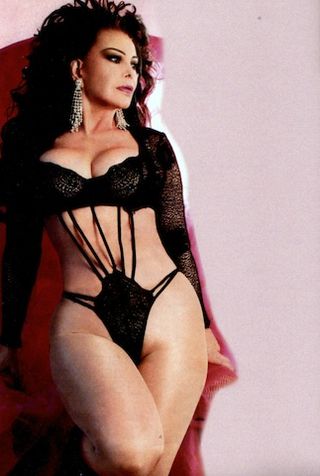
Mexican cinema dates to the late nineteenth century during the rule of President Porfirio Díaz. Seeing a demonstration of short films in 1896, Díaz immediately saw the importance of documenting his presidency in order to present an ideal image of it. With the outbreak of the Mexican Revolution in 1910, Mexican and foreign makers of silent films seized the opportunity to document its leaders and events. From 1915 onward, Mexican cinema focused on narrative film.

Yolanda Yvonne Montes Farrington, better known by her stage-name Tongolele, is an American dancer, actress and vedette.

An exploitation film is a film that tries to succeed financially by exploiting current trends, niche genres, or lurid content. Exploitation films are generally low-quality "B movies", though some set trends, attract critical attention, become historically important, and even gain a cult following.

Vicente Aranda Ezquerra was a Spanish film director, screenwriter and producer.

Nuevo Cine Mexicano, also referred to as New Mexican Cinema is a Mexican film movement started in the early 1990s. Filmmakers, critics, and scholars consider Nuevo Cine Mexicano a "rebirth" of Mexican cinema because of the production of higher-quality films. This rebirth led to high international praise as well as box-office success, unseen since the golden age of Mexican cinema of the 1930s to 1960s. The quality of Mexican films suffered in the decades following the golden age due in part to Mexican audiences watching more overseas films, especially Hollywood productions. This resulted in the rise of infamous Mexican genres such as Luchador films, sexicomedias and ultimately the low-budget direct-to-video Mexploitation film.

Mexploitation is a film genre of low-budget films that combine elements of an exploitation film and Mexican culture or portrayals of Mexican life within Mexico often dealing with crime, drug trafficking, money and sex.

Lilia Guadalupe Mendiola Mayares, better known by her stage name Lyn May, is a Mexican vedette, exotic dancer and actress. She was one of the most popular Mexican vedettes during the 1970s and 1980s, a popular sex symbol, and one of the main stars of Ficheras cinema.

Rosa Carmina Riverón Jiménez is a Cuban-Mexican actress and dancer.
The Rumberas film was a film genre that flourished in Mexico's Golden Age of Mexican cinema in the 1940s and 1950s. Its major stars were the so-called rumberas, dancers of Afro-Caribbean musical rhythms. The genre is a film curiosity, one of the most fascinating hybrids of the international cinema.

Sex in film, the presentation of aspects of sexuality in film, specially human sexuality, has been controversial since the development of the medium. Films which display or suggest sexual behavior have been criticized by religious groups or have been banned or censored by governments, although attitudes have changed much along the years and a more permissive social environment has developed in certain parts of the world, notably in Europe, North America, Australia and New Zealand. In countries with a film rating system, films which contain explicit sex scenes typically receive a restricted classification. Nudity in film may be regarded as sexual or as non-sexual.

The commedia sexy all'italiana, also known as commedia scollacciata or commedia erotica all'italiana, is a subgenre of the Italian commedia all'italiana film genre.

The representation of gender in horror films, particularly depictions of women, has been the subject of critical commentary.

A vedette is the main female artist of a show derived from cabaret and its subcategories of revue, vaudeville, music hall or burlesque. The purpose of the vedette is to entertain and captivate the public. Vedettes are expected to sing, dance and act on stage. Particularly accomplished artistes are considered super vedettes or first vedettes. Vedettes often appear alongside groups of dancers, flashy and revealing costumes, magicians, comedians, jugglers, or even performing animals. Vedettes specializing in burlesque generally do striptease and may also perform nude on stage.
Latin American nations have been producing national LGBT+ cinema since at least the 1980s, though homosexual characters have been appearing in their films since at least 1923.:75 The collection of LGBT-themed films from 2000 onwards has been dubbed New Maricón Cinema by Vinodh Venkatesh; the term both includes Latine culture and identity and does not exclude non-queer LGBT+ films like Azul y no tan rosa.:6-7 Latin American cinema is largely non-systemic, which is established as a reason for its wide variety of LGBT-themed films.:142

María del Rosario Mendoza Chávez was a Mexican vedette, actress, dancer, and singer. During the 1970s–1980s, she was one of the highest grossing artists in the Mexican sex comedy film genre.
Bellas de noche, also known as Las ficheras, is a Mexican film directed by Miguel M. Delgado. It was filmed in 1975 and starring Sasha Montenegro and Jorge Rivero. It is regarded as the film that began the rise of Mexican sex comedies film genre as a largely mainstream genre in the Mexican Cinema for about a decade and a half; the term "fichera" coming to mean the entire genre.

In feminist theory, the male gaze is the act of depicting women and the world in the visual arts and in literature from a masculine, heterosexual perspective that presents and represents women as sexual objects for the pleasure of the heterosexual male viewer. In the visual and aesthetic presentations of narrative cinema, the male gaze has three perspectives: that of the man behind the camera, that of the male characters within the film's cinematic representations; and that of the spectator gazing at the image.
Isabel Camila Masiero, better known by her stage name Princesa Yamal, is a Mexican vedette, actress and dancer of Argentine origin. She was one of the most popular Mexican vedettes during the 1970s and 1980s.
There are many Mexican LGBT+ films, a genre that has developed through the film history of the country since the 1970s.
Angelica Chain is a Mexican actress, model and vedette, who is best known for her acting in fichera films, many of which she participated playing the couple of another famous Mexican actor, Alfonso Zayas. Chain was once considered a sex symbol in Mexico.













